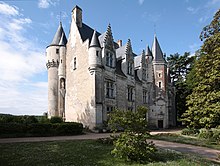Montrésor Castle
The Montrésor Castle is located in the municipality of Montrésor in the Indre-et-Loire department of the Center-Val de Loire region in France . Since February 13, 1996, it has been under monument protection as Monument historique .
Building history
The castle , built on a rocky promontory over the Indrois Valley, goes back, like many others, to Fulko Nerra , Count of Anjou . Some remains of the donjon from the 12th century with its surrounding wall have been preserved from this complex . This keep was one of the first to be built of stone, similar to the one in Loches .
The present castle was built by the then heir to Montresor, Imbert de Bastarnay , at the beginning of the 16th century. The advisor to several French kings and grandfather Diane de Poitiers preferred a simple but comfortable residential building instead of the original medieval fortress . The south facade, which overlooks the Indrois, is handsome with cross-frame windows , pointed gable windows and two corner towers with machicolations . On the courtyard side, a polygonal stair tower and high portholes catch the eye. The building with its late Gothic appearance already shows something of the newly awakened sense of the Renaissance for regularity.
Imbert de Bastarnay also had the neighboring collegiate church (now the parish church ) completed in 1541 . It is one of the most important religious buildings of the Renaissance in France. Bastarnay was probably worried about his fame, because his tomb should be in the center of the church choir . Destroyed in the French Revolution , restored in 1875, it finally found its current place in the nave .
Home of the Branicki family
In 1849 the castle came into the possession of Count Xavier Branicki , a Polish emigrant who killed Napoléon III in the Crimean War . to Constantinople . He had the dilapidated castle completely restored and refurbished. Everything has remained unchanged since then. A collection of paintings by French, Italian and Polish masters as well as gold and silver tableware from the Polish royal family is remarkable.
In the small salon there are a number of paintings that can be attributed to the connection between the master of the house and the Bonaparte family . A painting from 1799 by Élisabeth Vigée-Lebrun , favorite artist Marie Antoinette , shows the Polish princess Sapiéha. A painting by Charles André van Loo is reminiscent of a concert at Pascha's . On either side of the door are pieces of ebony furniture made by the École Boulle, a famous Parisian school. The 16th century fireplace comes from Villiers Abbey . In the library there are several portraits of family members created by Franz Xaver Winterhalter .
In the Grand Salon ornate wood carvings by the sculptor are Pierre Vaneau to see (1653-1694). These plaques, which remind of the fight against the Turks near Vienna , were the building of a memorial for Johann III. Dedicated to Sobieski . Below is a buffet with secret compartments owned by the Medicis , which was bought at an auction in Amboise Castle in 1852 . On the windows of the room there are Polish standards made of silk from the 18th century. The mantelpiece is decorated with the arms of the Branickis: three rivers, a crown and above them a small paddling dog.
literature
- Wilfried Hansmann : The Loire Valley. Castles, churches and cities in the «Garden of France» . 2nd Edition. DuMont, Cologne 2000, ISBN 3-7701-3555-5 , pp. 138-139 ( online ).
Web links
Individual evidence
- ↑ Montrésor Castle in the Base Mérimée of the French Ministry of Culture (French), accessed on June 2, 2009.
Coordinates: 47 ° 9 '20.8 " N , 1 ° 12' 4.4" E



